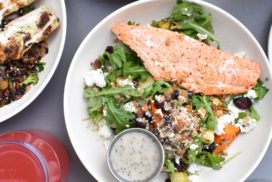When on a cut, the largest worry is usually muscle and strength loss. After bulking for months and adding on size, losing all that progress is a formidable prospect.
While no one loses all their muscle mass and strength as soon as they start eating below their maintenance calories, some muscle loss and loss of strength is to be expected from remaining in a negative energy balance for an extended period of time.
This is because when you are on a cut, the body is forced to use other sources of energy besides food. Both fat and muscle can be broken down by the body for energy. Ideally, a well designed cut will only burn fat, not lean mass. If you successfully hold on to most of your muscle, then a cut will strip away mainly your fat.
In order to preserve your muscle and strength during a cut you need to eat the right ratio of macronutrients, do resistance training with heavy weights, stay in a shallow, but effective caloric deficit, and maintain a healthy lifestyle.
Macronutrient Ratio
The right ratio of macronutrients will vary among different individuals. For example, women tend to need a higher amount of fat in their diet than men, and some weightlifters will not feel any negative effects from low-carb dieting while others will.
It is important to find the right ratio of macronutrients for you, however there are some general good ranges to be in to maximize the results of cutting and your strength. The best macronutrient ratio when cutting for the majority of people is around 2-2.2g of carbohydrates per pound of bodyweight, 1-1.6 grams of protein per pound of bodyweight, and .4-.6g of fat per pound of bodyweight.
This amount of fat may to be low for some people but, between eating less fat and eating less carbohydrates, reducing your fat intake is better.
Carbohydrates are needed because they are the primary source of energy and are vital for the muscle glycogen stores that are drawn from during training. When your carbohydrate intake is too low, your performance and strength while weightlifting will be negatively affected.
To preserve muscle and strength, a high carbohydrate intake will make the cut more effective and will also keep your mood, testosterone, and energy at healthy levels.
Keeping protein high will also help cut successfully because protein has the highest satiety of all macronutrients and is needed to repair the body. For most weightlifters, you need more protein than the average person as well as even athletes, since the goal of resistance training is to breakdown muscle which means the amount of protein synthesis is going to be much higher, placing a higher requirement on the amount of protein in your diet.
Hypertrophy and Strength Training
Next, along with making sure that your diet on a cut has high enough carbohydrates and protein, you also need to continue your hypertrophy and strength training without lowering the volume or the weights you are using.
Strength and muscle loss is often brought about by a lack of training. If you lift heavy weights consistently throughout your cut, this signals to the body that it needs to hold on to muscle since it is being used.
As soon as you reduce the amount of training you are doing, that allows the body to use your lean body mass as a source of energy because there is no longer any reason to maintain that muscle on your body.
So long as you are weightlifting multiple days per week, the amount of muscle which will be loss when cutting is going to be minimal.
Amount of Caloric Deficit
Another important variable for much fat you lose when cutting and how much muscle and strength you can maintain, is the amount of a caloric deficit you’re in.
A large caloric deficit of 500-800 calories per day will force the body to break down fat and muscle more rapidly than a shallower caloric deficit, such as 100-300 calories below your maintenance per day.
If your goal is quick weight loss, then the size of your caloric deficit should be large. For most weightlifters and bodybuilders however, the goal is not just weight loss, but rather fat loss. For quick fat loss, your caloric deficit should be high enough to lose ¼-2 pounds of weight per week but not so high than you are losing strength with each training session.
The right amount of calories beneath your maintenance will vary for every person, but a caloric deficit of 200-300 calories daily is usually optimal for a long and effective phase of cutting. For a shorter cutting phase, 300-500 calories below your maintenance is better, but it will be more difficult to retain strength and muscle the higher above a 500 calorie deficit you go.
Lifestyle
Lastly, you need a healthy lifestyle for the best results from cutting.
In order to optimize your lifestyle for retaining muscle and strength in a caloric deficit, you should sleep around 8 hours per night, avoid excess sugar, avoid frequent consumption of alcohol, limit drug use, and keep a balanced diet that provides all the micronutrients your body needs for hormones and keeping muscle.
Summary
Summarizing, in order to cut while maintaining muscle and strength, eat the right ratio of macronutrients, continue training at the same amount of volume you were while bulking or maintaining, stay in a reasonable caloric deficit that still works for fat loss, and live healthily by sleeping enough for recovery and avoiding drugs and “dirty foods” that negatively impact your hormones and health.
For more on bulking, cutting, and weightlifting, such as how to write a training program and how to get visible abs, click here.







